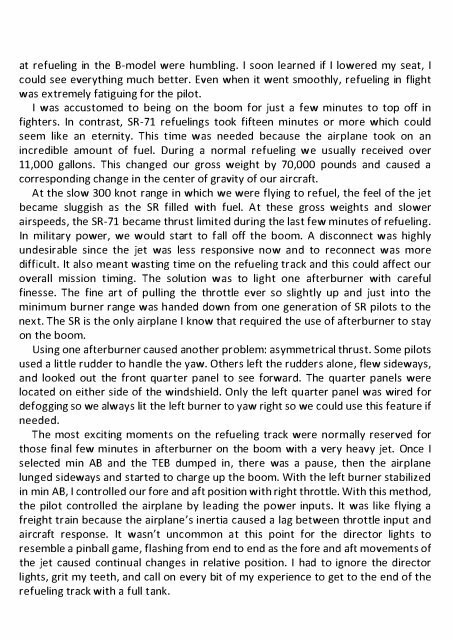Create successful ePaper yourself
Turn your PDF publications into a flip-book with our unique Google optimized e-Paper software.
at refueling in the B-model were humbling. I soon learned if I lowered my seat, I<br />
could see everything much better. Even when it went smoothly, refueling in flight<br />
was extremely fatiguing for the pilot.<br />
I was accustomed to being on the boom for just a few minutes to top off in<br />
fighters. In contrast, SR-71 refuelings took fifteen minutes or more which could<br />
seem like an eternity. This time was needed because the airplane took on an<br />
incredible amount of fuel. During a normal refueling we usually received over<br />
11,000 gallons. This changed our gross weight by 70,000 pounds and caused a<br />
corresponding change in the center of gravity of our aircraft.<br />
At the slow 300 knot range in which we were flying to refuel, the feel of the jet<br />
became sluggish as the SR filled with fuel. At these gross weights and slower<br />
airspeeds, the SR-71 became thrust limited during the last few minutes of refueling.<br />
In military power, we would start to fall off the boom. A disconnect was highly<br />
undesirable since the jet was less responsive now and to reconnect was more<br />
difficult. It also meant wasting time on the refueling track and this could affect our<br />
overall mission timing. The solution was to light one afterburner with careful<br />
finesse. The fine art of pulling the throttle ever so slightly up and just into the<br />
minimum burner range was handed down from one generation of SR pilots to the<br />
next. The SR is the only airplane I know that required the use of afterburner to stay<br />
on the boom.<br />
Using one afterburner caused another problem: asymmetrical thrust. Some pilots<br />
used a little rudder to handle the yaw. Others left the rudders alone, flew sideways,<br />
and looked out the front quarter panel to see forward. The quarter panels were<br />
located on either side of the windshield. Only the left quarter panel was wired for<br />
defogging so we always lit the left burner to yaw right so we could use this feature if<br />
needed.<br />
The most exciting moments on the refueling track were normally reserved for<br />
those final few minutes in afterburner on the boom with a very heavy jet. Once I<br />
selected min AB and the TEB dumped in, there was a pause, then the airplane<br />
lunged sideways and started to charge up the boom. With the left burner stabilized<br />
in min AB, I controlled our fore and aft position with right throttle. With this method,<br />
the pilot controlled the airplane by leading the power inputs. It was like flying a<br />
freight train because the airplane's inertia caused a lag between throttle input and<br />
aircraft response. It wasn't uncommon at this point for the director lights to<br />
resemble a pinball game, flashing from end to end as the fore and aft movements of<br />
the jet caused continual changes in relative position. I had to ignore the director<br />
lights, grit my teeth, and call on every bit of my experience to get to the end of the<br />
refueling track with a full tank.


